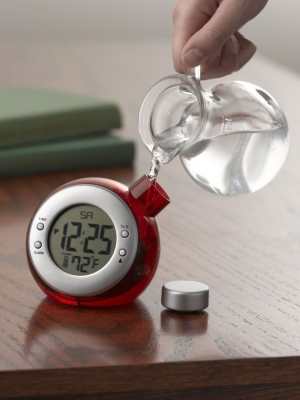
It always seems as if public clocks are simply around so that they come in handy to know the time for those times when you can’t bother to pull out your smartphone or check your watch. Some clocks pride themselves on being quirky, unique or perfectionists. Let’s check them out this month.
H2O powered clock
In Osaka, Japan, there is a water clock that has a very unique way of showing people the time. With 400 nozzles completely controlled by computers, the time is continuously displayed through sprays of water. Since it’s never really enough just to know the time, it also displays a variety of pre-programmed patterns. The water continuously collects in a basin and is recirculated. So, is this really unique clock worth 30 litres of water per minute?
Who likes to know more than just the time?
Verdensur is one of the most interesting clocks in the world, built by the famous clockmaker Jens Olsen. Located in Copenhagen, Denmark, this clock has it all covered for those of you who like to catch up on just what’s happening in the solar system. It shows the time in different locations on Earth, the position of certain celestial objects in the sky as well as lunar and solar eclipses. Hurray for the 15,448 parts that make this all possible!
Cuckoos, step aside…
Used to cuckoo clocks? Well, you are in for a big surprise if you visit the Villa Blois in France. As each hour approaches, six dragons (each measuring about 7 metres) emerge out of the windows, moving their heads, growling and spewing smoke! The spectacular show goes on for about five minutes and it’s so impressive that you’ll probably want to spend the next 55 minutes hanging around until it’s the time for the dragons to put on their show again.
Speaking of time and tide…
An astronomical clock inside Besancon Cathedral in France holds the proud title of being the most, complicated clock in the world. Not surprisingly, it has earned a room for itself in the clock tower. The clock bears animated pictures of eight harbours along the French coast, and for a good reason. This clock has dials that indicate the hours of high tides and their heights – a true sailor’s friend.
Take some ‘time’ to figure out the time
Our very modern, very digital life, has made us used to the luxury of knowing the time with just a glance. But Mengenlehreuhr in Germany is one clock that makes you work hard to know the time and makes the task about as enjoyable. as solving an equation. With a set of 24 illuminating lights, you’re expected to know that the yellow blinking light on the top denotes seconds, the top row indicates the hour, and the bottom row indicates the minutes and so on.
Look out for the ball!
Sure, it’s no longer the best way to help sailors, but it was a very important time-keeper back in the days of yore when smartphones and other modern clocks hadn’t been invented. Think of a ship’s captain desperate to keep his ship’s timepiece (a marine chronometer) up to date. He grabs a telescope and looks out in the exact direction and when he sees a ball falling down, hurray, he instantly knew the hour of the day!
An artistic masterpiece
It’s art! It’s an automaton exhibit! It’s a clock! When you visit the Hermitage Museum in Russia, you’ll find a thing of beauty. The Peacock Clock features three beautifully designed birds – an owl, a peacock and a rooster – that keep time. When the night ends and day begins, eerie music plays, the owl turns its head, the peacock moves tail and the rooster crows, finally ending the enchanting show. If only our clocks did this, waking up on time would be so much more fun!
Picture Credit : Google




